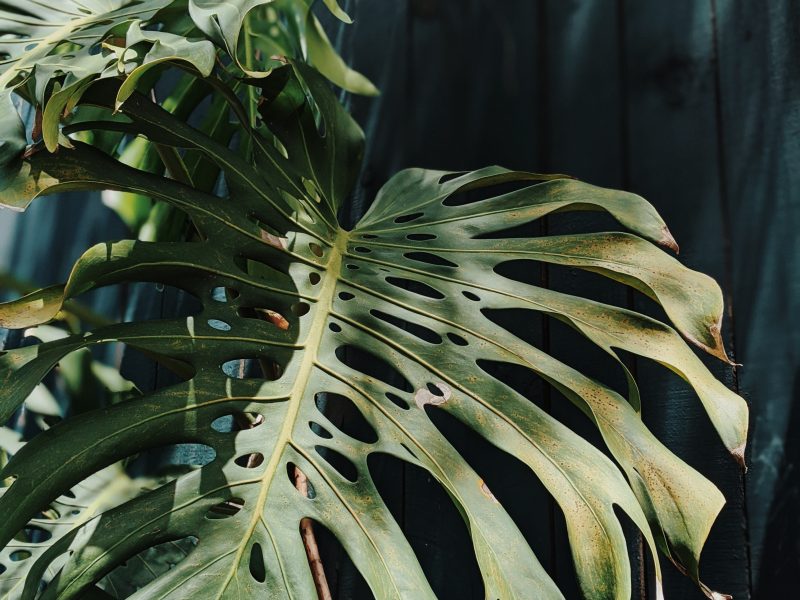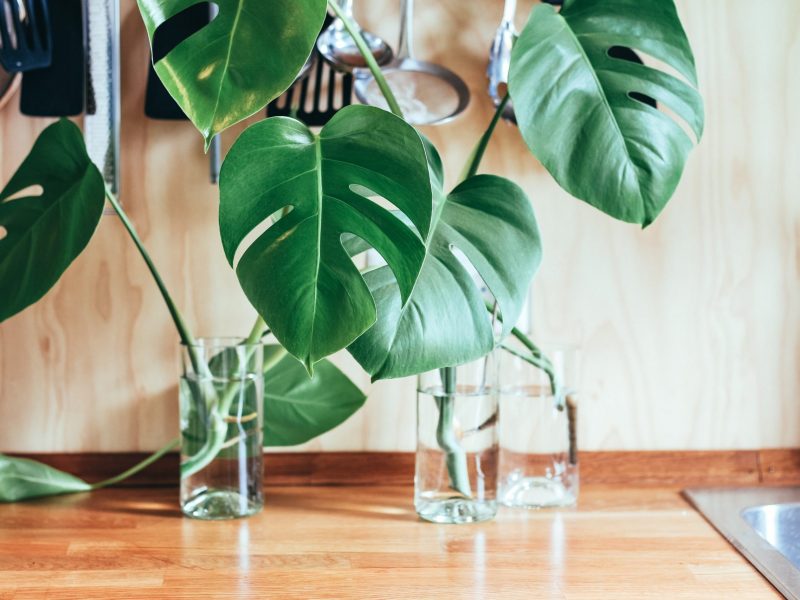
Monstera plants are known and loved for their lush, tropical foliage and striking appearance, but like all plants, they require regular maintenance to keep them looking their best. Pruning is an essential part of Monstera care that helps to promote healthy growth and prevent your plant from becoming too large, leggy or unruly.
However, many plant parents often feel intimidated by the idea of pruning their Monstera, unsure of where to start or how to go about it. We completely understand that it can feel counterintuitive to remove parts of your beloved Monstera!
In this guide, we’ll cover everything you need to know about pruning your Monstera, including why it’s beneficial to prune, when you should do it, how to make clean cuts, and what to do with the cuttings. Whether you’re a seasoned plant pro or a newbie to Monstera care, this guide will provide you with all the information you need to keep your plant looking healthy and beautiful.

The benefits of pruning a Monstera
If you’ve never pruned your Monstera or any of your other houseplants before, then you may not realise the benefits. Although cutting back to reduce size is one of them, this isn’t the only reason why you should be regularly pruning your Monstera.
Pruning promotes stronger growth
Pruning in the right way and at the right time can actually help to stimulate faster, stronger and larger growth.
This is because Monstera plants contain hormones within their stems and when the stem is cut, the hormones kick in to repair and regenerate the plant tissue. This leads to your plant producing new growth from that cut and if your plant is getting the right care and the environmental factors are right, that new growth will be stronger and larger.
If your Monstera has been a little slow at producing new growth during the months of spring and summer, then check that it’s not rootbound first. If this isn’t the case, then pruning your plant can help to stimulate new growth.
Pruning helps shape your plant
Monsteras can become quite wide and tall over time and often without you realising, it’s suddenly dominating the room.
Pruning back your plant is the best way to create the shape and size that you want or need for your home. If you’re looking for a fuller plant, then propagating the cuttings and adding them back into the mother plant can help achieve this.
Top tip: if your Monstera is spreading out a bit too much, but you don’t actually want to prune it, then use support stakes to hold the stems upright. This can reduce the space needed for your plant without actually removing any leaves.
Removing unhealthy parts of your Monstera
If your plant has developed issues such as yellow or brown leaves, then we recommend pruning off the worst affected areas. If the leaves have the odd brown leaf tip or a small brown patch then these should not be removed as they are still extremely valuable to your plant.
However, any leaves that are all or majority brown or yellow can be removed. There is no returning them to their luscious green and you don’t want your Monstera to waste any energy keeping them alive. Instead, by removing them you allow your plant to focus on new growth.
Removing small or leggy growth
Although you don’t tend to see much new growth on your Monstera during autumn and winter, if you do it tends to be small and a bit limp.
Whilst smaller leaves and leggy growth won’t actually negatively impact the health of your Monstera, removing them can help your plant look fresher.
Pruning can help to curb a pest infestation
If you have discovered pests on your Monstera (or signs of pests including brown or yellow spots, white webbing or powder across the leaves and stems) then we would always start by pruning the worst affected areas.
Although you’ll need to follow a rigorous treatment plan, pruning away the leaves with the most pests reduces the size of the infestation and makes it easier to tackle.
When to prune your Monstera
Spring or summer is best
The best time of year to prune your Monstera is throughout spring and summer. There are a few benefits of doing it during this time. Firstly, the sunny warm weather will provide a good environment for your Monstera to recover from the shock of pruning.
Secondly, because your Monstera will be entering the growth period, if you are pruning to stimulate growth then you’ll be quickly rewarded with new luscious leaves.
Pruning in spring and summer also gives you the best chance at successfully propagating the cuttings you remove (if you want to propagate them). This is because cuttings need plenty of sunshine and warm temperatures to grow roots and eventually new leaves.
Remove dying sections as they appear
Obviously, you can’t time any issues so that they appear only in spring and summer so you’ll need to react and prune them as they appear. Don’t throw away the leaves too quickly though as they can provide a lot of clues as to what the issue is. For example, the colouration, any patches on the leaves, holes and even the texture can help you identify the problem.
It’s worth noting though that sometimes Monsteras will naturally develop brown or yellow leaves as a very natural part of the ageing cycle. This is very normal and shouldn’t be anything you need to worry about so long as it’s only the odd leaf from time to time. Another way to diagnose brown/yellow leaves as natural ageing is if it’s only happening to the lowest, smallest leaves on your Monstera.
Tools needed to successfully prune a Monstera
Sharp scissors or shears
It’s vital that your tools are clean to avoid passing on any bacteria or dirt onto the mother plant (or the cuttings if you want to propagate them).
Gloves
Monsteras are mildly toxic to humans and when you cut through the stem, sap can be released. If you do come into contact with this sap, it can cause skin irritation This is why we recommend that you wear gloves when pruning a Monstera.
Transparent containers (only if you are propagating)
If you choose to propagate the parts of your plant that you remove, then it’s good to have some tall containers which you can transfer the new cuttings into. If you don’t want to keep the cuttings then maybe ask friends if they’d like to grow them (not many people will say no to free plants!). We always tend to use transparent containers when propagating as not only is it fun to track the root growth, but it will allow you to spot any issues quickly.
How to prune a Monstera: Our Step-by-Step Guide
Decide how much you want to or need to prune
It’s important to know what and where you are going to cut before you pick up your shears. You don’t want to be making random cuts so make sure to mark the stems where you want to prune. You always want to make sure that you are cutting just above a node. This is where future growth will develop so cutting just above it is ideal.
Because Monsteras are quite slow growers, we don’t recommend cutting too much more than desired. With some other houseplants that grow a lot quicker, we tend to recommend cutting off a bit more to leave room for it to grow. Otherwise, you’ll be right back at the pruning process in just a couple of months.
Make the cut(s)
Use your clean, sharp shears to make one or several cuts across your Monstera. It’s important that the cuts aren’t rough as this can damage the plant. Instead, you want clean quick cuts across the stem. This not only helps the mother plant but also means the cuttings can develop new roots easily.
Put any cuttings in water to propagate them
If you do want to propagate any offcuts that you prune from your Monstera, transfer these into a clear container filled with temperate water. You can only propagate the cutting if it has part of the stem as single leaves won’t grow any roots. Often you will see photos of single monstera leaves growing roots but without a node, these won’t ever develop into a plant. You can check out our full Monstera propagation guide to learn more.
How to care for your Monstera Plant after pruning
You might think that the work is done the moment you put down the shears, but there are actually a few things you need to pay attention to after pruning to ensure the health of your Monstera. Plants can become a little stressed during the pruning process, so can take a few days to recover. If you notice your plant drooping a little or curling up then this isn’t usually a cause for concern. Things should return to normal after a few days.
However, to help your plant produce new healthy growth, there are a few extra things you should be doing to promote this.
Firstly, you want to give your Monstera a good soak. You can either do this by top watering your plant and removing any excess water from the saucer, or you can give it a soak/shower. This will ensure that the roots and soil take up as much water as needed, without the risk of overwatering.
The second thing to pay attention to is if your Monstera is getting the right amount of light. Luckily they are pretty adaptable and can deal with a whole range of light conditions but it’s ideal if they are getting several hours of bright but indirect light. This helps to stimulate new growth and prevent any issues from occurring. The more sunlight your Monstera, the more splits it will also develop in its new leaves so this is an important one for aesthetic reasons too!
The one thing that you can forget about for a few weeks is fertilizing. In the few weeks following the pruning, your Monstera needs to recover a little. You may think that fertilizing will help stimulate new growth but it can be damaging to a weakened plant. Wait at least one month before continuing your normal fertilizing routine. If you aren’t fertilizing your Monstera, then that’s absolutely fine – you can still see plenty of new growth without it if the care routine and the environmental factors are right.
Frequently Asked Questions
When is the best time to prune my Monstera?
Sometime between late spring to summer is the best time to prune your Monstera. This is because your plant is entering the growth period which means it will recover from the shock quickly and reward you with plenty of new healthy growth.
It also means that any cuttings you decide to propagate have the best chance of growing roots and eventually new leaves.
How much should I prune my Monstera?
Exactly how much you cut depends on how you want to shape your Monstera. The only thing we recommend is leaving at least 2 or 3 leaves on each of the stems to ensure that they are able to regenerate quickly. If you cut too much off, there aren’t enough leaves to photosynthesise at a rate to sustain a strong level of new growth.
Can I propagate the cuttings I prune from my Monstera?
If you are pruning the stems then yes absolutely you can propagate the cuttings you take. You won’t, however, be able to propagate any single leaves (without part of the main stem) that you prune from your Monstera.
Does pruning my Monstera encourage new growth?
Because there are growth hormones in the stems of your Monstera, when the stems are cut, these hormones help to repair the tissue and grow new leaves.
How often should I be pruning my Monstera?
If your Monstera has outgrown its spot or you notice brown or yellow leaves on your plant, then it’s a good time to prune it. There isn’t a timeline to which you need to stick, it’s just something that you have to notice on your individual plant that it’s time to prune it.
Should I prune the roots of a Monstera too?
If your Monstera has suffered from root rot then we highly recommend pruning the root system of your plant. This will help your plant grow new healthy roots, rather than wasting energy trying to revive the dying ones. However, outside of this issue, there isn’t really a need to be pruning the roots in the same way that you are pruning the leaves and stems.
Should I use pruning sealant on the cuts on my Monstera?
There is actually no need as your Monstera’s stems will naturally form their own seal over the wound in about 20 to 30 minutes. Just make sure to leave the cuttings in a dry place and make sure not to come into contact with the sap as it is toxic and can cause mild skin irritation in some cases.
We hope now that the idea of pruning your Monstera isn’t quite as scary as you would have thought. Pruning your Monstera plant is actually an essential part of its care routine and can have some great benefits. By regularly trimming back excess growth and damaged leaves, you can help keep your Monstera healthy and thriving, and encourage it to produce new foliage.
And don’t be afraid to experiment with different pruning techniques and styles to find what shape works best for your plant and your own aesthetic preferences. With a little practice and patience, you can master the art of pruning your Monstera and enjoy a beautiful and thriving plant for years to come.
If you want to learn more about caring for your plant, check out our Monstera care guide.














